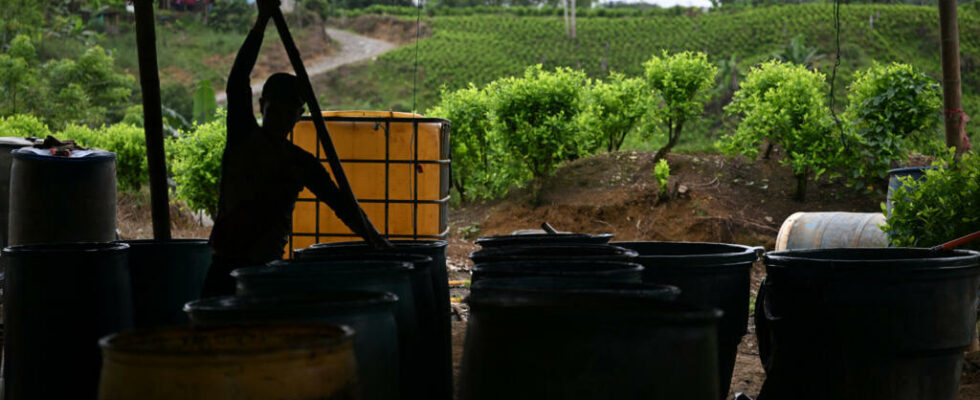Cocaine production exploded in 2023 in Colombia, reaching a new all-time high with an increase of 53%, according to a joint report from the Colombian government and the UN drug agency (UNODC).
3 mins
Cocaine hydrochloride production reached 2,664 tonnes in 2023, an increase of 53%, according to this report, made public Friday in Bogota. Areas cultivated with coca, the culture at the base of cocaine whose Colombia is the world’s leading producer, are also increasing by 10%, now covering 253,000 hectares of Colombian territory.
“ Contrary to the increase observed between 2021 and 2022, which was heavily concentrated in the department of Putumayo (southwest, bordering Ecuador), growth is this time more generalized ”, says the report. “ It concerns sixteen of the 19 departments » where the presence of coke is reported. Cauca (southwest) and Nariño (southwest), two regions where we observe a strong presence of armed groups, “ were most affected “. Four regions have coca cultivation areas greater than 30,000 hectares: Cauca, Nariño, Putumayo, and North Santander (north-east, bordering Venezuela).
Productions sometimes unsold
The report focuses in particular on fifteen production enclaves, concentrating 39% of the coca growing area on only 14% of the territory. He is also alarmed by “ expansion zones, areas where coca crops have only been present for three years », and 40% of which are located in the Pacific region, one of the poorest and most isolated in the country.
“ It is important to note that in different regions the prices of coca leaf derivatives (coca paste and cocaine base) are reaching historic lows. ”, while in other regions “ there is no market due to the absence of buyers “. “ Despite this, the vast majority of coca crops continue to be harvested ” And ” these market restrictions led to the stockpiling of cocaine paste and cocaine base ”, sometimes used “ as a means of commercial exchange in certain regions “.
“ Coca cultivation and cocaine production continue to be a threat to the conservation of the environment, biological and cultural biodiversity », according to the same report, as COP16, a major global forum on biodiversity, opens on Monday in Cali (south-west). This production is located 4% in national parks, 10% in indigenous reserves, 14% in forest reserves and 20% on the lands of black communities.
Also listenGrand Report – Colombia: synthetic drugs are disrupting drug trafficking
Armed groups
The most coca-cultivated areas are 98% occupied by at least one armed group. In certain towns close to production areas, the illicit cocaine economy represents more than 42% of the local economy. Armed groups involved in drug trafficking, such as the ELN (National Liberation Army), Marxist FARC dissidents or even paramilitaries “ remain linked to transnational organized crime, which focuses on the production and trafficking of cocaine “.
Certain production regions have thus converted “ in strategic points for illegal activities ”, with a “ intensification of trafficking, illegal mining and human trafficking “, as well as a “ wide availability of financing and specialization of production “.
These alarming figures are part of an international context of sharp growth in the cocaine market, both supply and demand, underlines this document, which estimates international consumption up 20% over the past ten years. North America, Western and Central Europe and South America constitute the largest markets for cocaine consumption in terms of number of users over the past year, according to this report.
Also readGuinea-Bissau: 2.6 tonnes of cocaine seized from an aircraft coming from Venezuela
